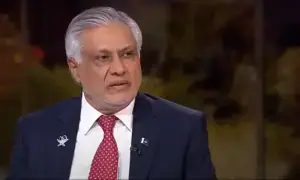Guide to Karachi water tankers, rates, contact numbers
Water tanker rates in Karachi have gone up to Rs6,000 for 2,000 gallons, as petrol prices crept up themselves.
Back in June last year, the Karachi Water and Sewerage Board also had to issue a notification, saying it was increasing its tanker rates by Rs400.
“We have to increase the prices due to the fuel hike,” he said while answering questions from Aaj News.
According to Abdul Hameed Bangash Water Tanker located in Clifton, a 1,000-gallon tanker cost Rs3,000 but as of April 2023, it is Rs6,000.
Around eight to ten thousand water tankers are supplied to Karachi residents daily, by rough estimates.
According to a tanker company owner, an average tanker will make four to five rounds to a hydrant every day. The filling costs are Rs700 for 1,000 gallons.
The hydrants are located towards Nipa, so for a tanker company based in Clifton, each round trip to the hydrant costs around Rs2,500 in fuel.
Abdul Hameed Bangash, the general secretary of All Sindh Karachi Water Tanker Association, said that the water hydrant contractors are corrupt and charge water tanker owners double the rates of what has been set by the government.
He said that private water tanker companies are the ones that end up suffering due to this corruption. “Ask these contractors if they’re tax filers, all they do is loot the common man,” he said.
The Karachi water board takes advantage of the Hub dam canal and charges each tanker Rs4,500 for a refill at the Crush water plant. Meanwhile, refilling your tank from the same canal in Baluchistan will cost you Rs2000, he said.
Rates in 2022
Earlier last year, water was being sold at a rate up to Rs11,000 for a single 5,000 gallon tanker. Half of the city does not get a supply of line water from the Karachi Water & Sewage Board. The irony is that the KWSB facilitates the tanker companies to do business.

One of the major suppliers is Ghulam Nabi Water Contractor. Their rates were Rs3,300 for a 1,000 gallon bowser last year. And they are charging Rs5,500 for a 2,000 gallon tanker and Rs11,000 is the rate for the 5,000 gallon water tanker.

“Karachi requires approximately 1,200 million gallons of water per day,” said Abdul Qadir Shaikh, the Director for Public Relations at the KWSB. “However, with a shortfall of 46%, the city is supplied approximately 600 million gallons per day.”
The numbers Shaikh is quoting are, however, quite old. The KWSB has not factored in growth of the city over the last ten years.
To cater the needs of its 16 million residents, said Shaikh, six hydrants are working in six districts. Part of the problem is not just the supply of water but also the operations of private water tanker companies, he said. (He says that Karachi is 16M people, but this number too is disputed by political parties such as the PPP and JI who question the census.)
“The water board made a deal with the water tanker companies,” said Shaikh. “It says that water tanker companies have to supply 45% of the daily water at the rates KWSB set.” These rates are set as the general public service (GPS) rates by the water board. The private companies can then sell the rest of the 55% of water from the hydrants at their commercial rates.
All six hydrants are given to these companies on contract. Every company has its own hydrant and operates from there. Ghulam Nabi is one such company that is operational from the hydrant in Gulshan-e-Iqbal. It supplies water to Clifton and Defence as well as in Gulshan-e-Iqbal.
The rates set by the water board for the general public service or GPS category is applied to a 20 km radius from where the tanker operates. If the customer’s house is at a distance of more than 20 km, then extra charges per kilometer are charged.


“At least 400 requests are received on a daily basis,” said Shahbaz Bashir, the water board’s focal person on hydrant affairs. “For the general public service, we have set an overall daily quota up to 400,000 gallons of water from all of our hydrants.”
The water board also charges a “bowser filling amount” from each tanker which is Rs420 for a 1,000 gallon tanker.
However, many neighbourhoods simply don’t get water in their normal KWSB lines and have been depending on tankers for years. Javed Iqbal of Bufferzone recalled, “As far as I remember, the water problem started in the late 2000s, somewhere around 2007.” Previously the area used to get line water. Now, tankers from Sakhi Hasan hydrant operates in Bufferzone. “We require at least 8 tankers of 1,000 gallons to cover our monthly water needs,” said Iqbal.
According to him, there are illegal hydrants in the area where a small bowser (tanki) charges Rs600. “Sweet water is relatively expensive as compared to khara water,” said Iqbal.

KWSB’s Abdul Qadir Shaikh said that the anti-theft cell has been trying to tackle illegal connections. “Most of the illegal connections are found in district West,” he said. (But this is also the area where the KWSB has not incidentally laid a pipe network to neighbourhoods such as Baldia). The majority of Karachi’s poor lives in district West where the water-deprived towns of Lyari, Kemari, SITE, Baldia and Orangi are located.
Making Karachi’s water problem even worse, is load-shedding that chokes the hydrants. “Since mid-May, we have been unable to operate on our 18-hour schedule and are working just 12 to 13 hours,” said Bashir. That means that supply never caters to demand.
The table shows the contact details of some of the water tankers.

For the latest news, follow us on Twitter @Aaj_Urdu. We are also on Facebook, Instagram and YouTube.















Comments are closed on this story.